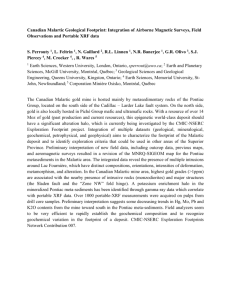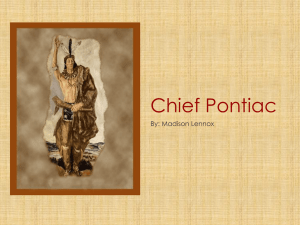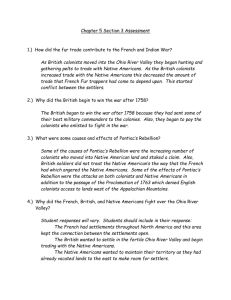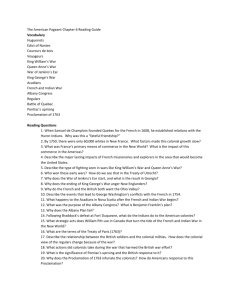Little Known Pontiac Facts - #4 - Chief Pontiac
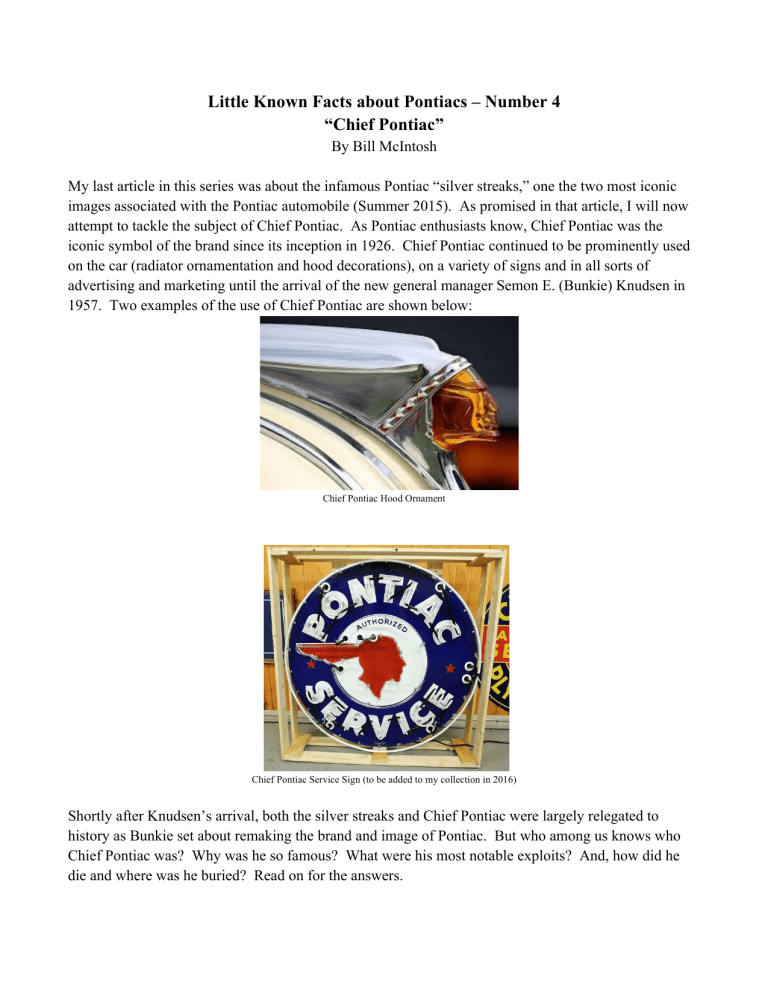
Little Known Facts about Pontiacs – Number 4
“Chief Pontiac”
By Bill McIntosh
My last article in this series was about the infamous Pontiac “silver streaks,” one the two most iconic images associated with the Pontiac automobile (Summer 2015). As promised in that article, I will now attempt to tackle the subject of Chief Pontiac. As Pontiac enthusiasts know, Chief Pontiac was the iconic symbol of the brand since its inception in 1926. Chief Pontiac continued to be prominently used on the car (radiator ornamentation and hood decorations), on a variety of signs and in all sorts of advertising and marketing until the arrival of the new general manager Semon E. (Bunkie) Knudsen in
1957. Two examples of the use of Chief Pontiac are shown below:
Chief Pontiac Hood Ornament
Chief Pontiac Service Sign (to be added to my collection in 2016)
Shortly after Knudsen’s arrival, both the silver streaks and Chief Pontiac were largely relegated to history as Bunkie set about remaking the brand and image of Pontiac. But who among us knows who
Chief Pontiac was? Why was he so famous? What were his most notable exploits? And, how did he die and where was he buried? Read on for the answers.
Pontiac was an Ottawa tribal war chief. He was born between 1712 and 1725 in an Ottawa village on either the Detroit or Maumee rivers. There is some mystery about his parents’ origins, but his mother was identified as an Ottawa while his father was either an Ojibwa or Miami. Nevertheless, Pontiac was always identified as an Ottawa by those who knew him, and He had also lived in close proximity to Fort
Detroit, sight of his attempted siege. By 1747, Pontiac had become an Ottawa war leader and he allied with New France against a resistance movement.
No images of Pontiac are known to exist – above is an interpretative painting by John Mix Stanley.
It is important to understand that the French who explored and made settlements in the Great Lakes
Region down to the Ohio Valley and up into Canada had made peace with local tribes. As opposed to the Spanish before them and the British that followed, the French embraced the local Indian populations.
When the British defeated the French following the French and Indian War, the architect of British
Indian policy, General Jeffrey Amherst, cut back on provisions customarily given to the Indians by the
French. Further and importantly, he restricted the distribution of gunpowder and ammunition, supplies the Indians needed for hunting which the French had generously given.
With the British colonists starting to enter areas formerly colonized by the French, native leaders began to call for the Indians to join with the French to drive the British out of the region. As part of that movement, Pontiac planned a surprise attack on Fort Detroit. In the spring of 1763, Pontiac and 300 fellow Indians attempted to take Fort Detroit. The commander of the Fort had been forewarned and successfully defended against the attack. Shortly thereafter, Pontiac and his followers laid siege to the
Fort and were eventually joined by more than 900 warriors from many tribes. News of Pontiac’s actions spread throughout the Ohio Valley, which resulted in widespread attacks by Indians against forts and settlements of the British. At one point, Indians controlled nine of eleven British forts in the Ohio
Valley.
Because of Pontiac’s influence and his success in combating them, the British decided to negotiate with the Ottawa leader. Pontiac met with the British Superintendent of Indian Affairs in the summer of 1766 and that meeting concluded formal hostilities between native Indians and the British. Having learned their lesson, they increased their presence in the years following “Pontiac’s War” and effectively ended any further uprising of Native Americans.
Pontiac’s influence declined in direct proportion to the buildup of British colonization and fortification efforts. In 1768, he conceded that he was no longer recognized as the chief by his people. Tragically,
Pontiac was murdered in the spring of 1769 near the French town of Cahokia. The murderer was a
Peoria warrior whose name was not recorded for the history books. Pontiac’s burial place is unknown, but evidence and tradition suggest that his body was taken across the river and buried in St. Louis.
Not surprisingly, Pontiac was memorialized and named for Pontiac, Michigan and Pontiac, Illinois the general region where he had so much influence. As a great ally of the French, it is equally not surprising that his name graces a town in Quebec, Canada and the Pontiac Regional County Municipality in
Quebec. There are no towns or cities in English-speaking (British) Canada that are named after the great
Indian leader – also not so surprising.
Of course, Pontiac was chosen as the name for a new car developed and produced by General Motors’
Oakland division, introduced in 1926 and in continuous production until 2010 when it was discontinued.


